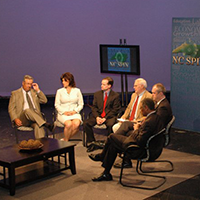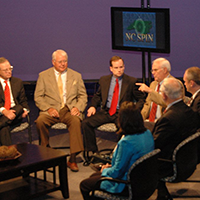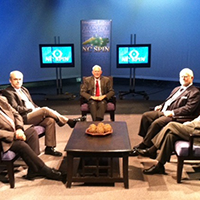Aycock name removal is 'de-Stalinization' in North Carolina
Published March 9, 2015
by Rob Christensen, News and Observer, March 7, 2015.
Gov. Charles Brantley Aycock was a hero and role model to many of the progressive leaders in North Carolina’s history.
Gov. Kerr Scott (1949-53) would speak reverentially of the time when the great Aycock visited his parents’ home when he was a little boy. Gov. Terry Sanford (1961-65) hung a portrait of Aycock in his office and paid tribute to him in his inaugural address. Gov. Jim Hunt (1977-85, 1993-2001) frequently quoted Aycock in his speeches.
Aycock’s words are set in stone on the outside wall of the Department of Education Building on the State Government Mall. His statue is on the Capitol grounds and represents the state in the U.S. Capitol. His birthplace in Wayne County is a state historical site.
Aycock, who was governor from 1901 to 1905, was venerated by generations of North Carolinians because he led a crusade to improve the state’s public schools at a time when the Tar Heel State had one of the worst school systems and the highest illiteracy rates in the country.
But Aycock, who died in 1912 of a heart attack while delivering an education speech in Alabama, is in the process of being made a non-person. If this were the Soviet Union, it would be called de-Stalinization.
His name was stripped from an annual Democratic fundraising dinner in Asheville started by Sanford. In recent days, the East Carolina University board of trustees voted to take his name off a dormitory at the Greenville campus. So did Duke University, and UNC Greensboro is taking a close look at Aycock Auditorium.
The effort is being led by African-Americans, and there is no mystery as to why they find Aycock offensive. Aycock was a leading spokesman for the white supremacy campaigns of 1898 and 1900 that led to the Democrats taking control of the state, the disenfranchisement of most black voters and the implementation of Jim Crow laws.
Aycock was a racist who believed in white supremacy, and there are plenty of quotations to back up those views.
But, then, it is the same for President Abraham Lincoln, who freed the slaves. There lies the rub. Lincoln may have signed the Emancipation Proclamation, but he did not believe in complete racial equality, and he talked about sending the freed slaves to Liberia, Haiti or Central America.
“Whether Lincoln ever went beyond being an anti-slavery white supremacist is a question that is difficult to resolve,” wrote historian George Frederickson.
Why stop at supremacy?
That is the problem with judging men in 2015 who lived in the age of the horse and buggy. It is not that their views should be excused, but they should be understood in the context of their times.
Aycock lived in a racist era. There was not only segregation in the South, but blacks faced widespread prejudice in the North. It was an age of Rudyard Kipling colonialism, where white Europeans thought it was the natural order of things to rule over people of color all over the world – whether they be in Africa, the Middle East or Asia.
During the Aycock age, the U.S. engaged in a brutal war to put down an armed Philippine independence movement that resulted in anywhere from 34,000 deaths (U.S. estimate) to 220,000 deaths (the Filipino estimate.) It is a war few Americans even remember today.
If we are to remove honors accorded long-dead white supremacists, what about slaveholders? Surely those who believed in and practiced slavery were at least as objectionable as those who believed in white supremacy.
Four of our first five presidents were slaveholders, including George Washington and Thomas Jefferson.
Twelve presidents were slaveholders, including the three claimed by North Carolina who are honored with a statue on the state Capitol grounds.
Why stop at just the racial wrongs done to African-Americans? Think of the Japanese-Americans locked up in detention camps during World War II with the blessing of President Franklin Roosevelt. Should schools or buildings named after Roosevelt also be re-evaluated?
Or how about women? Before 1920, women were not allowed to vote. Most of the pre-1920 political leaders were, in different ways, obviously complicit in this decision. Should the sexist politicians of yesteryear be punished?
If we start down this road, many of the buildings on college campuses will have to undergo a political cleansing.
It is hard for us to understand the politics of 1898 and 1900, which is just the point. While we should learn from the past, we should not try to erase it.
March 9, 2015 at 4:42 pm
CJ Small says:
African-Americans are not trying to erase history. On the contrary, they want it remembered accurately. They just don't want racists honored by having their names on buildings. Especially those paid for by taxpayers, including African-Americans. I am a white conservative Republican and I see their point. We have a solution here in Winston-Salem. I will share it sometime.
March 9, 2015 at 5:00 pm
Doug Lowder says:
Uh Rob, we have already been driving this road for awhile. I guess it is just now hitting someone who supported your beloved progressive cause. And you thought all progressives were pure as the driven snow.
March 11, 2015 at 7:08 am
jimmy p. rouse says:
How can we put anyone's name on a building. I think we all have sinned. Who can cast the first stone? So if we are all sinners how can we have our name on a building?
We must take down all the names or either rewrite the Bible.
September 26, 2015 at 9:19 pm
Chris Telesca says:
For that matter - why not change the name of the NCDP HQ building. We refer to it as Goodwin House, but it's actually got the name of a Red-Shirt terrorist attached to it. The sign in the front yard refers to it as the "Cameron Morrison Headquarters Building". Yes he was a Governor, but he was a Red-shirt racist.







